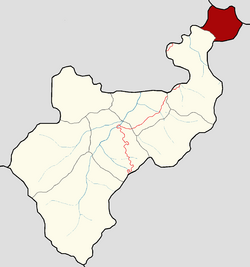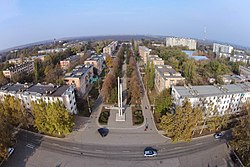Corridor Security Zone
Ekialdebeŕija Province
| |
|---|---|
 | |
| Country | |
| Established | 1 August, 1983 |
| Capital | Heŕibeŕija |
| Government | |
| • Secretary | Peruco Martiscorena |
| Area | |
| • Total | 1,881.6 km2 (726.5 sq mi) |
| Population (2017) | |
| • Total | 69,753 |
| • Rank | 4th in Lemovicia |
| • Density | 37.07/km2 (96.0/sq mi) |
| Time zone | UTC-1 (Central Euclean Time) |
| • Summer (DST) | not observed |
Ekialdebeŕija Province (Lemovician: Ekialdebeŕiko probincija, Miersan: Prowincja Nowa wschodnia, Savader: Újkeleti tartomány), formerly known as the Southern Corridor Security Zone (Lemovician: Hegoaldeko koŕidorejaren segurtasun gunea, Miersan: Strefa bezpieczeństwa korytarza południoweg, Savader: Biztonsági zóna a déli folyosón), and commonly known as the Corridor Security Zone, is a region, which according to Lemovicia, is a province, and is, according to West Miersa, part of the powiat of Krupiński in the voivodeship of Zanawiwasie. It is bordered to the southwest by the Lemovician Zelaja Province, to the northwest by the rest of the powiat of Krupiński, to the northeast by East Miersa, and to the southeast by TBD.
Established in 1983 upon the capture of the Południowy corridor by Lemovician forces from West Miersa in the Lemovician War, the Corridor Security Zone was proclaimed in order to protect the Południowy corridor from West Miersan attacks and to ensure that supply lines through Lemovicia would be uninterrupted.
Since the end of the Lemovician War in 1992, it continues to remain under Lemovician control, although nowadays, it is an officially trilingual region, recognising Lemovician, Miersan, and Savader as co-official languages.
In 2021, under the Second Amendment, the Corridor Security Zone was renamed Ekialdebeŕija Province and became an official province of Lemovicia, which led to tensions between West Miersa and Lemovicia.
History
Capture and annexation

After the end of the Miersan War in 1982 with the Treaty of San Alessandro, East Miersa was no longer able to support the fledgling Lemovician state, as the only way to go from East Miersa into Lemovicia was through the West Miersan powiat of Krupiński. Thus, East Miersa pressured the Lemovicians to take over parts of the powiat, in order for East Miersa to be able to supply the Lemovician forces in their fight against the West Miersans.
Thus, in 1983, under orders from the east, Ociote Sasiambarena's forces abandoned the defence of much of northwestern Lemovicia, and instead went on the offensive, with the aim of securing control of the Południowy corridor, and thus enabling East Miersa to supply weapons and other supplies to the Lemovician forces. By July of 1983, the Lemovicians were able to secure control of the corridor.
From the start, there was discussion as to its future status: Nikolas Lezana sought to annex it as a direct part of the Lemovician state, either by making it part of the Zelaja Province, or making its own province, while Ociote Sasiambarena sought to make the area into security zone. After heated discussions, it was decided to take Sasiambarena's approach, as Lemovicians have historically were not as present in the Południowy corridor as they were in the rest of Lemovicia.
Thus, on 1 August, 1983, the Corridor Security Zone was officially established, with its capital being based in Heŕibeŕija. From the start, it was under Lemovician military occupation, with martial law being in effect for all residents of the area. For the rest of war, although efforts were made by the West Miersan forces to retake the area, Lemovicians were able to repel the West Miersans, allowing them to maintain control over the corridor. However, as most of the Miersans in the area fled to West Miersa, it led to a smaller population, while the town of Heŕibeŕija was effectively destroyed by the end of the war.
Contemporary era

Following the end of the Lemovician War in 1992, while the Arciluco Agreement guaranteed Lemovicia the right to have a corridor through West Miersan-territory for "citizens, vehicles, and goods" to access Lemovicia from East Miersa and vice-versa unimpeded by the West Miersan government, Lemovicia would maintain control of the Corridor Security Zone.
In 1995, a civilian administration was introduced, with the establishment of municipal councils and one regional council. However, suffrage was limited to Lemovician citizens, with permanent residents not eligible to participate in the civilian administration, and remaining under martial law. The first person to head the regional council was Balogh Csaba. Under Csaba's administration, he focused on the reconstruction of the Corridor Security Zone, particularly Heŕibeŕija, which he envisioned as being "the gateway [into] Lemovicia" from East Miersa. To this end, he encouraged the resettlement of Lemovician IDPs into the area. Although the numbers of resettlement were not as high as in Zelaja, partially due to the terrain of the autonomous region, by 1997, ethnic Lemovicians formed around two-thirds of the population, making them the largest ethnicity in the Corridor Security Zone. However, he sought to promote minority rights: in 2002, Miersan and Savader were made co-official languages.
Following the shootdown of Lemavia Flight 1 in 2003, there were proposals to make the Corridor Security Zone into a province: while this was rejected by the National Assembly, the regional council was upgraded into a corridor council in 2005 with most of the powers of a province. However, Csaba was defeated by Ibone Baŕaondo in the elections, making Baŕaondo the head of the civilian administration of the Corridor Security Zone.
Under Baŕaondo's leadership, Baŕaondo saw the division of the CSZ into two regional councils following the 2007 census. She also focused on improving education, infrastructure, and healthcare for all residents in the security zone, which although popular among the residents, led to tension with the Revolutionary Defence Forces who expressed concern that their authority would be undermined. Despite the tension, she remained in office until 2015 when she stepped down.
Baŕaondo was succeeded by Vászoly Rajmund, who under his leadership prioritised improvements to urban infrastructure, particularly in Heŕibeŕija, as he wanted to make Heŕibeŕija "a pleasant city for its residents, and a place where one would get the best impression of Lemovicia." However, Vászoly's policies proved very unpopular with rural areas, while his "close ties" with the Revolutionary Defence Forces alienated many in the zone. Thus, in 2018, Vászoly was dismissed by the Corridor Council, and replaced with Peruco Martiscorena.
Although Martiscorena continued his predecessor's policies concerning Heŕibeŕija, Martiscorena also made his focus on expanding the role of civilian government in the Corridor Security Zone, seeing the continued maintenance of "two laws for two peoples" as being unsustainable for the CSZ. This culminated in the Lemovician government passing the Second Amendment in 2021 that transformed the Corridor Security Zone into Ekialdebeŕija Province, with the new province having the same rights as any other Lemovician province.
Government

Like other provinces in Lemovicia, the civilian administration of Ekialdebeŕija Province is organised along council lines: to this end, the only direct elections are held for district councils, who in turn elect municipal councils, who elect regional councils, who ultimately elect the Provincial Council (Lemovician: probincijala konceilua, Miersan: rada prowincji, Savader: tartományi tanács).
The Ekialdebeŕija Provincial Council, like other provincial councils, uses the delegate model of representation, with delegates being able to be recalled by their electors (the regional councils) at any time. It comprises of 70 seats, of which as of 2020, is comprised of 42 independent politicians and 28 members of the Lemovician Section of the Workers' International. It is based in Heŕibeŕija (Miersan: Białewłosy, Savader: Őszhaj).
Until September 2021, Ekialdebeŕija Province (then known as the Corridor Security Zone) had a military administration set up to deal with the affairs of non-citizens residing in, and soldiers stationed in the area. Although they had some offices at Heŕibeŕija, most affairs concering military administration are based in Topagunea and overseen by the Defence Ministry. Thus, policing in the area was done by the Revolutionary Defence Forces, until following the passage of the Second Amendment, when the Lemovician Police Force became responsible for all policing.
Demographics
As of the 2017 census, there were 69,753 persons residing in Ekialdebeŕija Province.
Ethnically, 53,896 people, or around 77.3% of the population, are ethnic Lemovicians. 10,148 people, or around 14.5% of the population are Savaders, while 4,845 people, or around 7.0% of the population, are Miersan. Finally, 864 people, or 1.2% of the population, are comprised of other ethnicities, primarily Vedmedis.
Linguistically, the Ekialdebeŕija Province is trilingual, recognising Lemovician, Miersan, and Savader as official languages. As of the 2017 census, 42,011 people, or around 60% of the population, spoke Lemovician as a first language. 18,302 people speak Miersan as their first language, making up 26.2% of the population. This is followed by Savader, spoken by 8,727 people as a first language, or 12.5% of the population. Finally, 713 people speak other languages, or around 1% of the population.
Religiously, around 60% of the population are adherents to Sotirianity, or 41,852 people, with the two main sects being the Lemovician Episemialist Church, practiced by 39,610 people, or 56.8% of the region's population, and Catholicism, practiced by 846 people, or approximately 1.2% of the region's population. Other sects are practiced by 2% of the population, or 1,396 people, including Witterism. Of the remaining 40%, 27,305 people, or around 39.1% of the population, are irreligious, with 596 people adhere to other religions, or around 0.9% of the population.